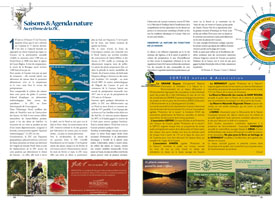107mm in 24 hours. That is the enormous quantity of water that fell on Cayenne on 17 January last. That gives an idea of how appropriate the adjective ‘humid’ is when describing the tropical climate of French, where average annual rainfall is between 1700mm in the North East and 3800mm in the region of Cacao-Régina. As a point of comparison, the middle of Brittany has about 1400mm per year.But French Guiana is not a country of monsoons. Rather it is a place of alternating seasons where the key parameter is not temperature or wind but the amount of rainfall.
As a first step to understanding the rhythm of the seasons in this part of the world, it is necessary first to explain a meteorological phenomenon well-known to climate specialists – the ITCZ, or Inter-Tropical Convergence Zone. In the North Atlantic the north-easterly tradewinds are caused by the Azores High. To the south the equally well-known South Atlantic High causes the south-easterly trade winds. These two winds meet in a cloudy, humid depression commonly called the ‘meteorological equator’. This gives rise to the ITZC.
The ITZC more or less follows the geographical equator, though to be precise this zone of low pressure is found at about latitude 5° north. It is the way the ITZC shifts around this position which determines the climate in French Guyana. This zone tends to follow the sun, drifting north in summer and south in winter. In this way the movement of the ITZC affects the life of the inhabitants of French Guiana by its impact on how dry each season is – or rather, how much rainfall there is.
In mid-December the ITZC returns from its summer residence and settles squarely over French Guiana. This is the little rainy season. The sky remains overcast until mid-February. Fortunately in the months of February and March the ITCZ brings a respite when it settles a little to the South over the equator. This is the little summer of the month of March, a good time to leave your wellies to one side for a bit.
In April the Convergence Zone starts moving northwards. The ITZC, under the influence of the unstable activity of the South Atlantic and the Azores Highs, wobbles around French Guiana until the month of July. The rainy season proper is the least sunny period of the year. In other words, brief but frequent downpours affect highly localised areas. To give but one example, in April 2007 the meteorological station of Dégrad des Cannes, the seaport in French Guiana, beat its records for monthly rainfall, recording 1017mm and a peak of 152mm in 24 hours.
Often after hesitating for a bit in July, the ITCZ heads north for good during the month of August, returning up beyond the 10th parallel. This is the period of cyclones in the Antilles and dry south-easterly trade winds. The temperature can rise above 30°C and you need to get into the forest to find some cool air. Everybody is outside. For a few months French Guiana is a wonderful place to live.
But meteorology is not an exact science. The region’s climate results from a series of events and climactic phenomena operating at the planetary scale. Observations of the rhythm of the seasons in French Guiana show a certain degree of variability from one year to the next, even over the medium term. From one year to the next the dates when the seasons begin and end can vary by several weeks. Observing sea currents such as El Niño and La Niña in the South Pacific and improved understanding of their impact on the planet has enabled the scientific community to establish a link with weather conditions in French Guiana. But that is another story.
OBSERVING NATURE THROUGH THE SEASONS
The climate has an important influence on the life of animals, plants, and nature in general. The volume of rainfall, the number of hours of sunshine and the temperature all have an impact on the life of living organisms. In French Guiana one of the most remarkable examples of this interdependence is provided by wading birds. The vast majority of these small birds which live on the coast and feed on the mudflats only live in French Guiana for part of the year. During the summer they breed in the great expanses of North America before setting off in their thousands to spend the winter in the warmth of the South American continent, and especially the coasts on the Guiana Shield.
The marine turtles are another example of cyclical events: for millions of years they have come to lay their eggs on the beaches of French Guiana.
Finally, the season can have an effect on when trees produce fruit, thus causing fruit eating birds such as toucans to move with the seasons, leaving the Guianese interior around the month of June to go to the coastal plain which has more fruits, and especially palm trees.




 English
English Français
Français  Português
Português 






 Télécharger l'article en PDF est réservé aux abonnés Web !
Télécharger l'article en PDF est réservé aux abonnés Web ! 
 Pas de réaction
Pas de réaction Comment!
Comment!


 Voyages avec Tooy. Histoire, mémoire, imaginaire des Amériques noires : Editions Vents d’ailleurs, 2010
Voyages avec Tooy. Histoire, mémoire, imaginaire des Amériques noires : Editions Vents d’ailleurs, 2010
 Guyane. Produits du terroir et recettes traditionnelles. L’inventaire du patrimoine culinaire de la France : Editions Albin Michel, 1999
Guyane. Produits du terroir et recettes traditionnelles. L’inventaire du patrimoine culinaire de la France : Editions Albin Michel, 1999
 Alunawalé, un voyage à travers les milieux naturels de Guyane : Office National des Forêts, 2009
Alunawalé, un voyage à travers les milieux naturels de Guyane : Office National des Forêts, 2009
 Augusta Curiel, Fotografe in Suiriname 1904 – 1937 : Libri Misei Surinamensis, 2007
Augusta Curiel, Fotografe in Suiriname 1904 – 1937 : Libri Misei Surinamensis, 2007


